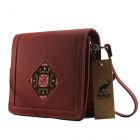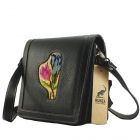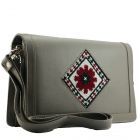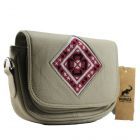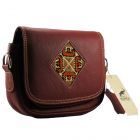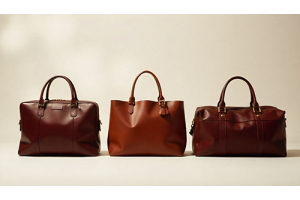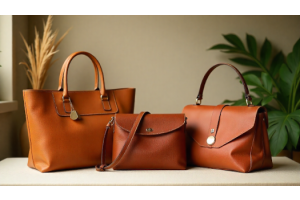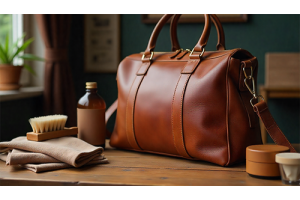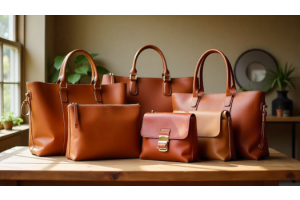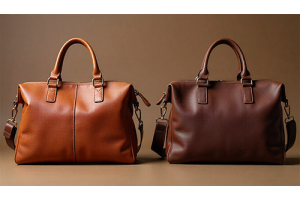Crafting Excellence: How Leather Goods Are Made
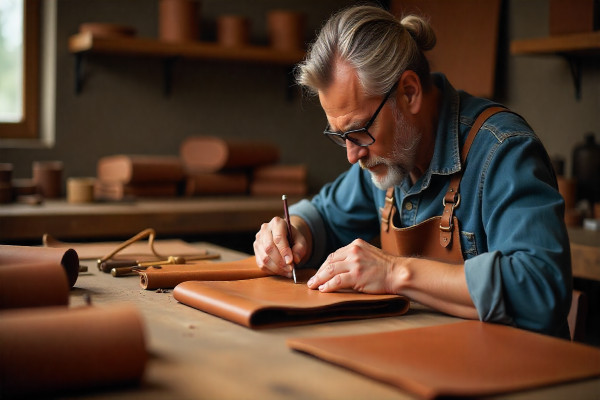
Crafting Excellence: How Leather Goods Are Made
Leather goods aren’t just products — they’re the result of centuries-old craftsmanship, precision, and artistry. Each piece, from a finely stitched wallet to a hand-polished leather bag, tells a story of skill and dedication. The process begins with selecting premium hides and continues through meticulous tanning, cutting, and stitching, often blending traditional handcrafting with modern techniques. This fusion of heritage and innovation ensures that every leather item isn’t merely functional but also timeless in style and durability. In this guide, we’ll explore the fascinating journey of how raw leather transforms into exquisite, long-lasting goods.
- 1. Introduction – Crafting Excellence: How Leather Goods Are Made
- 2. Selecting the Perfect Leather Material
- 3. The Tanning Process – Transforming Raw Hides
- 4. Cutting and Shaping the Leather
- 5. Stitching and Assembly – Where Craft Meets Precision
- 6. Finishing Touches and Quality Inspection
- 7. Sustainability in Modern Leather Craftsmanship
- 8. Conclusion
- 9. FAQs
Introduction – Crafting Excellence: How Leather Goods Are Made
Leather craftsmanship is more than just a manufacturing process — it’s an art form built on precision, patience, and passion. Every handcrafted leather item, whether a sleek wallet, sturdy belt, or elegant handbag, carries the mark of human skill and tradition. The journey begins with raw hides carefully selected for quality, then transformed through tanning, cutting, stitching, and finishing into durable works of art. This process combines centuries-old methods with modern innovation to ensure each piece not only looks beautiful but lasts for years. In this guide, we’ll explore how artisans craft excellence at every stage — from material selection to the final polish — revealing what truly makes leather goods timeless.
- Leather goods are the result of skilled craftsmanship and timeless artistry.
- Each piece is carefully handcrafted from high-quality hides selected for strength and texture.
- The process involves tanning, cutting, stitching, and finishing to achieve perfection.
- Artisans blend traditional handcrafting methods with modern precision tools.
- Every finished product reflects durability, elegance, and a commitment to excellence.
Tip
True leather craftsmanship starts with patience. Every stage — from selecting premium hides to the final polish — requires attention to detail and respect for the material. The more care and time invested, the more timeless and durable the final leather piece becomes.
Selecting the Perfect Leather Material
The foundation of every premium leather product lies in choosing the right material. Not all leather is created equal — each type has its own texture, durability, and purpose. From full-grain leather, prized for its natural beauty and strength, to top-grain and genuine leather, each serves a unique role in craftsmanship. Artisans carefully inspect every hide for quality, ensuring it’s free of flaws and has the right balance of softness and toughness. This careful selection process ensures that each finished piece not only looks elegant but also stands the test of time.
- The quality of a leather product starts with selecting the right hide.
- Full-grain leather is the most durable and naturally beautiful option.
- Top-grain leather offers a smoother finish while maintaining strength.
- Genuine leather is more affordable but less durable than higher grades.
- Artisans inspect each hide for texture, flexibility, and imperfections before use.
Style Meets Functionality
Choosing the right leather material is where craftsmanship truly begins, blending the artistry of design with the practicality of daily use. Every artisan knows that the soul of a leather product lies in its material — the texture, flexibility, and grain define its character. Full-grain leather, known for its natural imperfections and unmatched durability, develops a beautiful patina over time, telling the story of its use. Top-grain leather, slightly refined for a smoother finish, balances strength and sophistication, making it ideal for premium handbags, belts, and wallets. Genuine leather, though more economical, still provides a fine look for less demanding uses. The selection process isn’t just technical — it’s intuitive, rooted in experience and touch. Skilled craftsmen evaluate each hide by hand, feeling for suppleness, checking for flaws, and visualizing how it will perform once shaped and stitched. This attention to detail ensures that every finished piece embodies both beauty and purpose — proving that in leather craftsmanship, true excellence comes from harmony between style and functionality.
- Choosing the right leather defines both the style and strength of the final product.
- Full-grain leather offers unmatched durability and develops a rich patina with time.
- Top-grain leather provides a smoother surface while retaining flexibility and elegance.
- Genuine leather delivers an affordable option with a refined appearance for light use.
- Artisans handpick each hide, checking texture, grain, and imperfections to ensure top quality.
- This balance of beauty and practicality makes every handcrafted leather piece truly timeless.
| Leather Type | Characteristics | Durability | Best Used For |
|---|---|---|---|
| Full-Grain Leather | Retains the natural surface with visible grains and unique texture that improves over time. | Very High | Luxury bags, belts, wallets, and premium accessories. |
| Top-Grain Leather | Lightly sanded for a smooth, polished finish while maintaining strength and flexibility. | High | Handbags, shoes, and professional accessories. |
| Genuine Leather | Processed from lower layers of hide, offering an affordable and versatile option. | Moderate | Casual bags, light-use items, and fashion accessories. |
| Bonded Leather | Created from leftover leather fibers bonded with adhesives for a budget-friendly material. | Low | Budget accessories and decorative products. |
Key Benefits of Selecting the Perfect Leather Material
Selecting the right leather isn’t just about looks — it defines the product’s quality, lifespan, and comfort. The material determines how well a leather item ages, how it feels to the touch, and how it stands up to daily wear. When artisans choose premium hides, they ensure each piece reflects both durability and sophistication. High-quality leather retains its structure, develops a beautiful patina over time, and resists cracking or tearing. It also provides better flexibility, breathability, and an unmistakable sense of luxury that synthetic alternatives can’t match. Simply put, the perfect leather material transforms an ordinary item into a timeless masterpiece built to last.
- Ensures long-lasting durability and resistance to daily wear and tear.
- Maintains structure, shape, and elegance even after years of use.
- Develops a rich patina over time, adding unique character and depth.
- Provides natural flexibility and breathability for superior comfort.
- Offers a luxurious feel and premium look unmatched by synthetic materials.
- Reflects expert craftsmanship and attention to detail in every piece.
The Tanning Process – Transforming Raw Hides
CThe tanning process is the heart of leather craftsmanship — where raw animal hides are carefully transformed into durable, flexible, and long-lasting leather. Without tanning, hides would simply decay over time. This process preserves the natural fibers, giving leather its unique strength, texture, and resistance to wear. Artisans use two main tanning methods: vegetable tanning and chrome tanning. Vegetable tanning relies on natural plant extracts like tree bark and leaves, producing thick, earthy-toned leather with a distinct aroma and character. Chrome tanning, on the other hand, uses chromium salts for a faster process, resulting in softer, more versatile leather suited for fashion goods. Every stage of tanning — from soaking and liming to dyeing and finishing — requires precision and experience. The result is leather that not only looks beautiful but also performs exceptionally, ready to be crafted into products that stand the test of time.
- The tanning process converts raw hides into strong, flexible, and long-lasting leather.
- It prevents natural decay, preserving the hide’s fibers and structure.
- Vegetable tanning uses natural plant extracts for a rich texture and earthy tone.
- Chrome tanning relies on chromium salts for a softer and more versatile finish.
- Each step — soaking, liming, dyeing, and finishing — requires skill and precision.
- The result is premium-quality leather that blends durability with timeless beauty.
| Tanning Method | Process Description | Key Characteristics | Common Uses |
|---|---|---|---|
| Vegetable Tanning | Uses natural tannins from plants, bark, and leaves to preserve hides. | Eco-friendly, thick texture, rich natural tones, and distinct leather aroma. | Belts, saddles, wallets, premium bags, and artisanal goods. |
| Chrome Tanning | Uses chromium salts for faster processing and a softer finish. | Lightweight, flexible, water-resistant, and smooth in texture. | Fashion accessories, shoes, clothing, and upholstery. |
| Combination Tanning | Blends vegetable and chrome tanning techniques for balanced quality. | Durable yet supple, consistent color, and long-lasting finish. | High-end handbags, footwear, and luxury accessories. |
Cutting and Shaping the Leather
Once the leather has been tanned and finished, the next step in craftsmanship is precision cutting and shaping. This stage defines the structure, fit, and final appearance of the product. Artisans carefully study each hide, identifying its strongest and most flexible areas to ensure minimal waste and maximum durability. Every cut must be intentional — one wrong move can affect the entire design. Traditionally, craftsmen use sharp knives or steel templates to hand-cut the leather, while modern workshops may rely on laser or die-cutting machines for greater accuracy and efficiency. After cutting, the pieces are shaped, molded, and prepared for stitching. In this step, the artisan’s experience truly shines — balancing form, function, and aesthetics. The goal is to create a seamless foundation where every curve, fold, and edge aligns perfectly, ready for assembly into a timeless leather masterpiece
- After tanning, the leather is carefully cut to define the shape and structure of the product.
- Artisans inspect each hide to identify its strongest and most flexible areas before cutting.
- Precision is essential — even a small cutting error can impact the final design.
- Traditional hand-cutting tools and modern laser machines are both used for accuracy.
- Each piece is then shaped, molded, and refined to prepare for stitching and assembly.
- This stage ensures perfect alignment of every edge, fold, and curve for a flawless finish.
Key Elements of Advantages of Cutting and Shaping the Leather
Cutting and shaping are not just technical steps — they are where craftsmanship and precision meet creativity. This stage ensures that each leather product has the right balance of structure, strength, and visual appeal. A well-cut piece of leather enhances comfort, improves fit, and highlights the material’s natural beauty. It also reduces waste by maximizing the usable area of each hide. Skilled artisans understand how to adapt different thicknesses and textures for specific designs, ensuring consistency and quality across every product. The precision achieved during cutting and shaping directly influences the durability, functionality, and elegance of the final creation, making it a crucial part of exceptional leather craftsmanship.
- Ensures precise structure and balance in every leather product.
- Enhances the natural beauty and texture of the leather through clean, accurate cuts.
- Maximizes material efficiency by reducing waste during production.
- Improves comfort, flexibility, and fit for the final product.
- Allows artisans to adapt thickness and texture based on design requirements.
- Directly contributes to the durability, functionality, and overall elegance of the finished item.
Practical Benefits – Advantages of Cutting and Shaping the Leather
The cutting and shaping stage offers more than just aesthetic precision — it delivers real, functional benefits that define the quality and longevity of leather goods. Accurate cutting ensures that each piece fits together perfectly during assembly, reducing stress on seams and preventing early wear. Proper shaping allows the leather to retain its form while adapting naturally to use, enhancing both comfort and usability.
- Ensures precise alignment of leather pieces for stronger, longer-lasting products.
- Reduces stress on seams and joints, preventing early wear or tearing.
- Allows leather to retain its natural form while adapting comfortably to use.
- Maximizes the usable area of each hide, reducing material waste.
- Improves finishing quality with smooth edges and consistent stitching.
- Enhances both the appearance and performance of the final leather product.
- Combines functionality with craftsmanship, ensuring durability and refinement.
| Aspect | Benefit | Impact on Product |
|---|---|---|
| Precision Cutting | Ensures exact alignment and consistency of all leather pieces. | Improves strength, structure, and visual balance of the final product. |
| Material Efficiency | Reduces leather waste by maximizing usable hide surface. | Promotes sustainability and cost-effective production. |
| Shape Retention | Allows the product to maintain its form while adapting to daily use. | Enhances comfort and long-term durability. |
| Seam Integrity | Prevents uneven tension or strain during stitching. | Increases product lifespan and reduces repair needs. |
| Finishing Quality | Creates smooth edges and consistent stitching across the design. | Gives a refined, professional appearance to the leather item. |
Stitching and Assembly – Where Craft Meets Precision
Traditional hand-stitching techniques, such as saddle stitching, are still favored for their strength and authenticity, while modern machines add efficiency and consistency for large-scale production. Artisans often reinforce stress points and edges to maintain structure and prevent wear. During assembly, every component — from zippers and buckles to linings and handles — is integrated with care to create a seamless final product. This is the moment where craftsmanship and precision meet, turning carefully prepared materials into functional works of art built to last for generations.
- The stitching and assembly stage brings together all prepared leather pieces into a finished product.
- Every stitch is placed with precision to ensure strength, symmetry, and lasting beauty.
- Traditional hand-stitching methods like saddle stitching provide exceptional durability.
- Modern machines are used to maintain consistency and speed in large-scale production.
- Reinforced stitching is applied at stress points and edges for added strength.
- All components — including zippers, buckles, and linings — are assembled with care and accuracy.
- This process blends craftsmanship and precision, creating leather goods built to last for years.
| Aspect | Technique | Purpose | Result |
|---|---|---|---|
| Hand Stitching | Uses traditional saddle stitching with waxed thread and needles. | Ensures superior strength and a classic handcrafted appearance. | Durable seams that resist wear and enhance product authenticity. |
| Machine Stitching | Employs industrial sewing machines for precision and speed. | Provides uniform stitching and efficiency in production. | Clean, consistent seams ideal for large-scale manufacturing. |
| Reinforced Seams | Extra stitching at stress points and high-use areas. | Prevents tearing and maintains the product’s structure over time. | Improved durability and longer product lifespan. |
| Edge Finishing | Edges are burnished, painted, or folded for a smooth look. | Protects edges from fraying while adding a refined finish. | Enhanced aesthetics and resistance to daily wear. |
| Component Assmbly | Handles, zippers, linings, and buckles are attached with precision. | Combines functionality with design harmony. | A perfectly balanced, seamless final product. |
Finishing Touches and Quality Inspection
he final stage of leather craftsmanship focuses on refining and perfecting each piece to ensure it meets the highest standards. Finishing touches enhance both the appearance and functionality of the product, including edge burnishing, polishing, dyeing, and adding protective coatings. These details not only create a visually appealing finish but also strengthen the leather against wear, moisture, and everyday use. Quality inspection is equally critical. Skilled artisans examine every seam, stitch, and surface for imperfections, checking that the product maintains its intended shape and durability. This meticulous review ensures that each leather item leaving the workshop reflects excellence, consistency, and timeless beauty. By combining finishing techniques with rigorous quality control, artisans transform raw leather into polished, long-lasting pieces that stand out for both craftsmanship and performance.
- Finishing touches enhance the appearance, texture, and durability of leather products.
- Techniques include edge burnishing, polishing, dyeing, and protective coatings.
- These steps strengthen leather against wear, moisture, and daily use.
- Quality inspection ensures all seams, stitches, and surfaces meet high standards.
- Artisans check for consistency, shape retention, and overall craftsmanship.
- The combination of finishing and inspection guarantees a polished, long-lasting product.
- Every leather item leaving the workshop reflects excellence, precision, and timeless beauty.
Sustainability in Modern Leather Craftsmanship
Eco-friendly tanning methods, such as vegetable tanning or reduced-chemical processes, are replacing traditional, more polluting techniques. Additionally, many workshops prioritize reducing waste by using offcuts creatively and recycling scraps into smaller products or accessories. Sustainable leather craftsmanship also involves producing durable goods designed to last for decades, reducing the need for frequent replacements. By combining traditional skills with environmentally conscious practices, modern leather artisans are creating products that not only exude quality and style but also align with ethical and ecological values.
- Responsible sourcing ensures hides come from ethical and traceable origins.
- Eco-friendly tanning methods, like vegetable tanning, reduce chemical impact.
- Workshops minimize waste by creatively using offcuts and recycling scraps.
- Durable leather products reduce the need for frequent replacements.
- Combining traditional craftsmanship with sustainable practices promotes ethical production.
- Modern sustainable leather goods balance quality, style, and environmental responsibility.
| Sustainable Practice | Method | Benefit |
|---|---|---|
| Responsible Sourcing | Obtaining hides from ethical, traceable sources. | Supports animal welfare and ensures transparency in the supply chain. |
| Eco-Friendly Tanning | Using vegetable tanning or reduced-chemical processes. | Minimizes environmental pollution and chemical usage. |
| Waste Reduction | Recycling offcuts and repurposing scraps into smaller products. | Reduces material waste and promotes resource efficiency. |
| Durable Design | Crafting long-lasting leather goods intended for decades of use. | Decreases the need for replacements and lowers environmental impact. |
| Ethical Craftsmanship | Blending traditional skills with sustainable production methods. | Ensures high-quality products while respecting environmental and ethical standards. |
Conclusion
The art of leather craftsmanship represents the perfect fusion of tradition, skill, and careful attention to detail, where every stage of production contributes to the creation of exceptional products. From the very first step of selecting the finest hides, ensuring they possess the right texture, strength, and flexibility, to the intricate processes of tanning that preserve and enhance their natural qualities, each action reflects a deep understanding of the material. Cutting and shaping require precision and foresight to maximize usability while maintaining aesthetic balance, and stitching and assembly bring together artistry and structural integrity, ensuring seams are both strong and visually harmonious. Finishing touches, including polishing, edge refinement, and protective coatings, elevate the product’s appearance while safeguarding its longevity, and rigorous quality inspection guarantees that every item meets the highest standards. Modern leather artisans also integrate sustainable practices, responsibly sourcing hides, reducing waste, and employing environmentally conscious tanning methods, demonstrating that luxury and ethics can coexist. The culmination of these meticulous steps transforms raw hides into leather goods that are not only functional and stylish but also enduring, embodying timeless elegance and craftsmanship. Understanding this journey allows us to truly appreciate the skill, dedication, and artistry invested in every piece, highlighting why high-quality leather products remain lasting symbols of excellence, sophistication, and sustainable design.
FAQs
1. What is the first step in making high-quality leather goods?
The process begins with selecting the finest hides, which are inspected for texture, strength, and flexibility to ensure they are suitable for crafting durable, beautiful leather products.
2. What are the main methods of tanning leather?
The two primary tanning methods are vegetable tanning, which uses natural plant extracts, and chrome tanning, which uses chromium salts. Vegetable tanning produces a thicker, more natural finish, while chrome tanning results in softer, more flexible leather.
3. Why is cutting and shaping important in leather craftsmanship?
Cutting and shaping determine the structure, fit, and aesthetic appeal of the final product. Precise cutting ensures minimal waste, optimal use of each hide, and prepares the leather for seamless assembly.
4. How does stitching affect the quality of leather goods?
Stitching is crucial for durability and appearance. Traditional hand-stitching like saddle stitching provides exceptional strength, while machine stitching ensures consistency and efficiency in production.
5. What role do finishing touches play in leather products?
Finishing touches, such as edge burnishing, polishing, dyeing, and protective coatings, enhance both aesthetics and durability, ensuring that the product looks refined and resists wear over time.
6. How is sustainability incorporated into modern leather craftsmanship?
Modern artisans use responsibly sourced hides, eco-friendly tanning methods, waste reduction techniques, and produce durable products designed to last, combining traditional craftsmanship with environmental responsibility.
7. Why are handcrafted leather goods considered timeless?
Handcrafted leather goods combine durability, style, and artistry. Each piece is carefully made to last decades, developing a unique patina over time, which adds character and timeless appeal.

